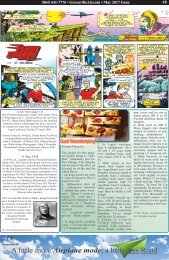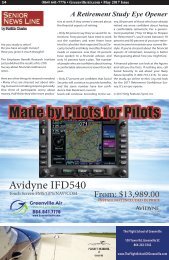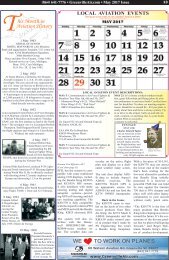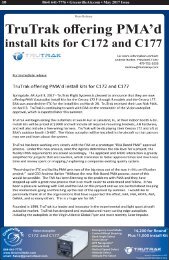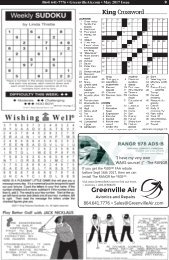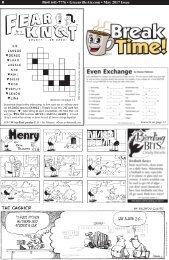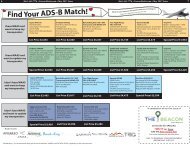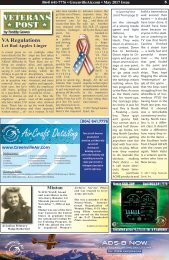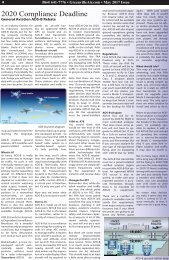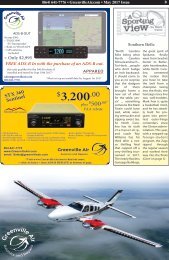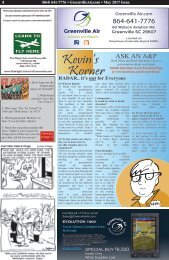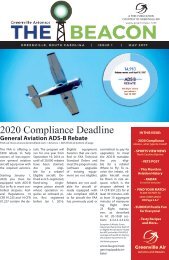You also want an ePaper? Increase the reach of your titles
YUMPU automatically turns print PDFs into web optimized ePapers that Google loves.
<strong>12</strong><br />
(864) 641-7776 • GreenvilleAir.com • May 2017 Issue<br />
MEDICATIONS DATABASE<br />
AOPA offers a list of FAA approved/disapproved medications for flight<br />
https://www.aopa.org/go-fly/medical-resources/medications-database<br />
FAA Policy<br />
The Federal Aviation Regulations include<br />
no specific references to medication usage.<br />
FAR 61.53 prohibits acting as pilot-in-command<br />
or in any other capacity as a required<br />
pilot flight crewmember, while that person:<br />
• Knows or has reason to know of any medical<br />
condition that would make the person<br />
unable to meet the requirement for the<br />
medical certificate necessary for the pilot<br />
operation, or:<br />
• Is taking medication or receiving other<br />
treatment for a medical condition that results<br />
in the person being unable to meet<br />
the requirements for the medical certificate<br />
necessary for the pilot operation.<br />
Further, FAR 91.17 prohibits the use of “any<br />
drug that affects the persons faculties in<br />
any way contrary to safety.”<br />
The FAA generally disallows certain types of<br />
drugs that are continuously used for treatment.<br />
These include, but aren’t limited to,<br />
anticoagulants, antiviral agents, anxiolytics<br />
(anti-anxiety), barbiturates, chemotherapeutic<br />
agents, experimental, hypoglycemic,<br />
investigational, mood altering, motion sickness,<br />
narcotic, sedating, antihistaminic, steroids,<br />
or tranquilizers.<br />
However, there is no official FAA “list” of<br />
drugs that is available to the public. Because<br />
FAR 91.17 doesn’t include the names<br />
of the prohibited drugs, there is no requirement<br />
that the drugs being taken be made<br />
known to the FAA prior to completing an<br />
FAA airman medical application and physical<br />
examination. There are several thousand<br />
controlled prescription drugs currently approved<br />
by the U.S. Food and Drug Administration.<br />
This doesn’t include OTC (over the<br />
counter) drugs. Virtually all drugs have the<br />
potential to cause adverse side effects in<br />
some people.<br />
That’s one reason why so many medications<br />
carry the generic warning to avoid operating<br />
heavy machinery or motor vehicles<br />
while using the drug. These warnings pose<br />
obviously greater significance for flying.<br />
While some individuals experience no side<br />
effects with a particular drug, others may<br />
be noticeably affected. Since each person’s<br />
response is different, the FAA has to consider<br />
the worst possible reaction to a drug in<br />
evaluating the decision to allow flight duties.<br />
Risks of medication usage<br />
Drugs that cause no apparent side effects<br />
on the ground can create serious problems<br />
with only moderate increases in altitude.<br />
Even for general aviation pilots flying at<br />
relatively low altitudes, the changes in concentrations<br />
of atmospheric gases, including<br />
oxygen and nitrogen, in the blood can<br />
enhance the effects of seemingly innocuous<br />
drugs and result in impaired judgment,<br />
decision-making, and performance.<br />
Remember, too, that medication usage is<br />
part of a two-sided coin. Medications are<br />
prescribed to treat a medical condition and<br />
the condition itself may be considered disqualifying<br />
with or without medication usage.<br />
Some of the most commonly used OTC<br />
drugs, antihistamines and decongestants,<br />
have the potential to cause some of the<br />
most noticeable side effects and may well<br />
be disqualifying as a result. The symptoms<br />
associated with common upper respiratory<br />
infections, even a bad cold, will usually<br />
suppress a pilot’s desire to fly, and treating<br />
symptoms with a drug that causes side effects<br />
only compounds the problem. Allegra<br />
(fexofenadine), Claritin (loratidine) and Hismanol<br />
(astemizole) are noted to be nonsedating<br />
and are allowed by the FAA, even<br />
though you still might not be legal under<br />
FAR 61.53. Remember, a bad head cold may<br />
be a “medical deficiency” under the regulations.<br />
For other pulmonary conditions such as<br />
asthma, the FAA approves the use of inhalers,<br />
including Proventil, Azmacort, Becanase,<br />
or Vancenase, on a case-by-case basis,<br />
based on a review of the history of symptoms.<br />
Many antihypertensive and cardiac drugs<br />
may also be allowed, case-by-case. For<br />
blood pressure control, five categories of<br />
medications are acceptable: angiotensin<br />
converting enzyme inhibitors (ACE) inhibitors,<br />
beta adrenergic blocking agents, calcium<br />
channel blockers, alpha-adrenergic<br />
blocking agents, and diuretics encompass<br />
about 60 different acceptable medications.<br />
Other cardiac drugs, such as antiarrhythmics,<br />
may also be approved, based on the<br />
condition for which the medications are<br />
prescribed. Agents used to control angina<br />
(chest pain) called nitrates, including nitroglycerine,<br />
are not permitted.<br />
Any drug that produces drowsiness or other<br />
central nervous system effects and experimental<br />
or investigational drugs are prohibited.<br />
These medications include narcotic<br />
analgesics, stimulants, sedatives, hypnotics,<br />
amphetamines, barbiturates, anti-anxiety<br />
drugs, muscle relaxants, tranquilizers,<br />
and antipsychotics (neuroleptics). Among<br />
the drugs classified as stimulants is Ritalin,<br />
which is used to treat attention deficit disorder<br />
(ADD). Lithium carbonate, used to treat<br />
certain types of depressive disorders, may<br />
be allowed after careful case evaluation.<br />
All antidepressants, including the newer<br />
generation of selective serotonin reuptake<br />
inhibiting (SSRI) medications, such as Paxil,<br />
Prozac, Effexor, Celexa, and Zoloft, are currently<br />
disqualifying, regardless of the reason<br />
for their use. These medications are often<br />
prescribed for “off label” use, that is, they<br />
are treating symptoms other than those for<br />
which the Food and Drug Administration<br />
approved the medication. Again, the underlying<br />
symptoms and diagnosis may be disqualifying,<br />
and the use of an antidepressant<br />
medication compounds the situation.<br />
Anticonvulsants, including phenytoin (Dilantin)<br />
and carbamazepine (Tegretol) are<br />
disqualifying because of the specific medical<br />
history that may include a prior seizure,<br />
seizure-like event, or risk of seizure. Although<br />
these drugs minimize the possibility<br />
of a seizure recurrence, their usage does<br />
not absolutely preclude another event.<br />
AOPA’s medication database<br />
Find out the FAA’s position on medications<br />
in this database compiled by the AOPA Pilot<br />
Information Center. The status of some<br />
medications changes from time to time so<br />
check back periodically. The database information<br />
is verified with the FAA Aerospace<br />
Medical Certification Division in Oklahoma<br />
City.<br />
If you do not see a particular medication<br />
in the database, please call the AOPA Pilot<br />
Information Center, 800/USA-AOPA (872-<br />
2672), and speak with one of the medical<br />
certification specialists . For a more in-depth<br />
review of your medical records, consider<br />
enrolling in AOPA’s Pilot Protection Services<br />
program.<br />
Search the medication database at: https://<br />
www.leftseat.com/medcat1.htm<br />
FLASHBACK ANSWERS:<br />
Answers<br />
1. 69 minutes. According to the<br />
Guinness Book of World Records,<br />
“The Devil Glitch,” by Chris Butler in<br />
1997, had 500 verses.<br />
2. The Doors, in 1967. The song<br />
was banned in at least one location<br />
for being controversial.<br />
3. Dobie Gray. Multi-talented Gray<br />
was at home with pop, country, adult,<br />
R&B and gospel.<br />
4. Boney M, in 1977.<br />
5. “For the Love of Him,” by Bobbi<br />
Martin, in 1969. Facing the wall of<br />
the women’s movement, this song<br />
was released ... and vanished in two<br />
months. A Philadelphia DJ, however,<br />
wasn’t ready to let it go. He made<br />
calls and got Martin club bookings,<br />
including a stint on “Dick Clark’s<br />
American<br />
Bandstand.” The song became popular<br />
and soared all the way to No. 1.




